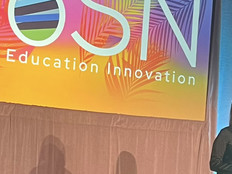Anyone involved in a one-to-one initiative knows it can be much more complicated than just rolling out a cartful of Chromebooks and logging on to a Wi-Fi network. As IT director for Arizona’s Humboldt Unified School District, about 90 minutes north of Phoenix, Patrick Keeling has experienced this challenge firsthand.
HUSD is working toward what Keeling calls a one-to-one access program: The district’s 5,800 K–12 students don’t carry devices with them all the time, but they can grab one off a charging cart and use it whenever they need to.
Last spring, the district began transitioning its older laptops to Dell 3180 and 3189 Chromebooks. At the same time, Keeling says, the district also moved to Google’s G Suite.
Before the transition, Keeling decided the district could use some help moving to Google apps. So HUSD called on Amplified IT, a Norfolk, Va.-based firm that specializes in helping K–12 schools implement Google for Education.
“There’s such a depth to what you can configure in G Suite,” he says. “Amplified helped us get through that. They even provided some deployment tools so we could get the machines set up and onto the network.”
Amplified also helped the district migrate from its mail server and “provided a multitude of other services in the G Suite,” he says. The company continues to provide ongoing support; Keeling says the district probably calls them two or three times a week.
“It’s typically something like, ‘We want to roll out this service — what do we do?’ ” says Keeling. “Or it’s, ‘A teacher stumbled across this feature. Can you help us figure out why it isn’t working how we think it should?’ ”
The need for tech help varies greatly, says Leila Nuland, managing content director for K–12 at Hanover Research, which surveys school districts across the U.S. to help them assess their technical and professional development needs.
Some of the variables include grade level, teachers’ comfort with technology and how far along the district is in its one-to-one program.
“Your elementary teachers might be further along than your high school teachers,” she says. “We try to get districts to slice the data in different ways so they can figure out how to target and customize their professional development initiatives.”
MORE FROM EDTECH: 5 key traits for a successful professional development initiative.
K–12 Professional Development Is Constantly Shifting
When it came to getting educators up to speed, HUSD turned to another professional services company, EdTechTeam, to develop a cadre of Google Certified Trainers who could share their expertise with the rest of the district.
Humboldt started with a cohort of 30 instructional specialists and teachers who showed a passionate interest in technology; they then set out to train other educators across the district.
The goal was to expand what the tools could do for instruction and see how they impact the classroom. At publication time, more than 75 percent of HUSD’s teachers were Level 1 Google Certified Educators.
“The double-edged sword of G Suite is that things are constantly changing — functionality is being added, buttons are moving,” Keeling says. “So, the training was less ‘Here’s exactly how to do this’ and more ‘Here’s how you can use this set of tools in your classroom.’ ”
Keeling says partnering with an experienced professional services firm saved the district a lot of time and troubleshooting. “If you try to do this yourself, and you’re not meticulous about how you set it up, you’re in for a lot of headaches and stumbling along the way,” he says.
What To Do When Technology Training Resources Are in Short Supply
In small rural districts like Hoxie Public Schools, technology resources are especially scarce. Located two hours northeast of Little Rock, Ark., Hoxie features a single K–12 campus with 900 students and roughly 1,200 laptops and desktops, including computer labs and staff machines.
Hoxie is now a one-to-one school district, featuring low-cost laptops such as the Lenovo 100e or convertible touch-screen tablets like the Lenovo 300e. But it took five years and a lot of effort to get there, says Technology Coordinator Darrell Parks.
“In rural Arkansas, the poverty level is really high,” Parks says. “You have problems getting bandwidth, and funding is a constant issue. As a small school, we didn’t have the money to go in and do one-to-one in a single year. First, we had to get our wired infrastructure up to par, then our wireless, and then we started buying laptops. It’s been a really long game.” Another thing in short supply was technical training, he adds.
While teachers in Arkansas are required to get 60 hours of professional development each year, there’s no equivalent requirement for technology specialists.
So, four years ago, Parks decided to create his own conference where school IT coordinators could talk with vendors, share best practices, attend seminars on topics such as networks and cybersecurity, and obtain Google Certification.
Last year, about 350 people, representing 136 schools, attended the Arkansas Conference of Technology. This year, Gov. Asa Hutchinson gave the keynote address.
“Sometimes, it’s just good to sit down with another school and see what they’re doing,” says Parks. “We’ll have roundtable discussions where we ask, ‘How do you manage your laptops or keep up with work tickets?’ We want to encourage everyone to be the best they can be, because our job is to facilitate education through the devices that we service.”
MORE FROM EDTECH: Add professional development to boost blended learning programs.
Teacher Certifications Can Help Get Educators on Board
For technologists, staying current on the latest advances is essential, says Parks. But what Hoxie really needs is someone who can bring that knowledge about tools and devices to educators.
“I’m not good at teaching teachers how to use technology,” Parks admits. “We are actively looking for a technology coach who can bridge the gap between me, the super-techy nerd guy, and the person who’s actually teaching in the classroom.”
Parks is looking for someone like Andrea Tolley, Microsoft Imagine Academy Educator at Greeneville Middle School, 75 miles east of Knoxville, Tenn.
Tolley not only teaches essential digital skills to Greeneville’s 720 sixth- through eighth-graders, but also works to spread that knowledge to her fellow teachers.
Greeneville was recently named a Microsoft Showcase School for the second year in a row, in part because it features four teachers — out of just seven in the entire state — who have been recognized as Microsoft Innovative Educator Experts.
Tolley was the school’s first MIE Expert, and she recruited the other three. All of them completed a series of self-paced online courses on how to master various Microsoft products. In addition, teachers can receive certifications in different Microsoft Office tools via the Imagine Academy.
“Kids can apply the skills they learn to their classwork, and teachers can become certified in Word, PowerPoint or Excel in the Imagine Academy as well,” she notes. “I’ve also had secretaries and custodians get certifications.” She says that about 20 teachers at Greeneville have been certified in Word, about 15 in PowerPoint and five or six in Excel.
Tolley says that another key benefit of being an MIE Expert is access to the Microsoft Educator Community online, where she can bounce around ideas and get answers to questions.
“If I don’t know how to do something, I can put a question in a chat window online and get an answer in no time flat,” she says. “Whereas, if I’m trying to figure it out myself, it’s going to take forever. Calling on a whole roomful of brains is so much better than trying to do it all by yourself.”
SAMR Integration Model Redefines Classroom Education
Following the Substitution Augmentation Modification Redefinition model, the ultimate goal of bringing technology into the classroom is to evolve from substituting digital tools for analog ones, through augmentation and modification of lesson plans, to redefining how educators teach, says Nuland.
“How do you create new tasks that wouldn’t be possible without having that technology in the classroom?” she asks.
Doing a baseline assessment of how technology is being used in a district is a necessary first step, says Nuland. That’s also a good way to identify educators who are taking the lead and can serve as examples to others.
“You may have teachers doing innovative things in small pockets that can help spearhead your professional development,” she says. “If teachers have peers who can say, ‘This is what it looks like, and this is the success I’ve had,’ that’s really powerful for program adoption. If you don’t have anything like that, it tells you that you’re going to need outside support.”









